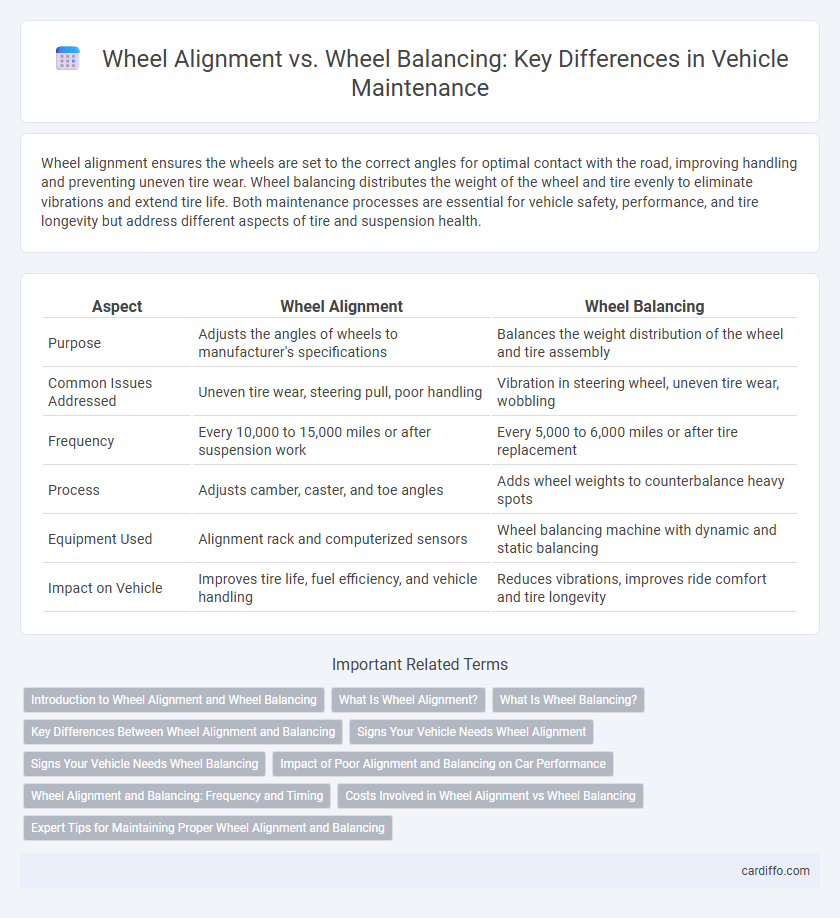Wheel alignment ensures the wheels are set to the correct angles for optimal contact with the road, improving handling and preventing uneven tire wear. Wheel balancing distributes the weight of the wheel and tire evenly to eliminate vibrations and extend tire life. Both maintenance processes are essential for vehicle safety, performance, and tire longevity but address different aspects of tire and suspension health.
Table of Comparison
| Aspect | Wheel Alignment | Wheel Balancing |
|---|---|---|
| Purpose | Adjusts the angles of wheels to manufacturer's specifications | Balances the weight distribution of the wheel and tire assembly |
| Common Issues Addressed | Uneven tire wear, steering pull, poor handling | Vibration in steering wheel, uneven tire wear, wobbling |
| Frequency | Every 10,000 to 15,000 miles or after suspension work | Every 5,000 to 6,000 miles or after tire replacement |
| Process | Adjusts camber, caster, and toe angles | Adds wheel weights to counterbalance heavy spots |
| Equipment Used | Alignment rack and computerized sensors | Wheel balancing machine with dynamic and static balancing |
| Impact on Vehicle | Improves tire life, fuel efficiency, and vehicle handling | Reduces vibrations, improves ride comfort and tire longevity |
Introduction to Wheel Alignment and Wheel Balancing
Wheel alignment involves adjusting the angles of the wheels to the manufacturer's specifications to ensure optimal tire contact with the road, improving handling and preventing uneven tire wear. Wheel balancing distributes the tire and wheel weight evenly around the axle to reduce vibrations and extend tire life. Proper maintenance of both wheel alignment and balancing is crucial for vehicle safety, fuel efficiency, and smooth driving performance.
What Is Wheel Alignment?
Wheel alignment involves adjusting the angles of the wheels to ensure they are set to the car manufacturer's specifications, improving vehicle handling, tire lifespan, and fuel efficiency. Proper alignment corrects issues like uneven tire wear and steering pull, preventing premature tire damage and enhancing overall driving safety. Regular wheel alignment checks are essential for optimal vehicle performance and maintaining road grip.
What Is Wheel Balancing?
Wheel balancing involves equalizing the weight distribution of a tire and wheel assembly to ensure smooth rotation and reduce vibrations. It is achieved by adding small weights to specific points on the wheel, preventing uneven tire wear and enhancing driving comfort. Proper wheel balancing extends tire life and improves vehicle stability, especially at higher speeds.
Key Differences Between Wheel Alignment and Balancing
Wheel alignment adjusts the angles of the wheels to the vehicle manufacturer's specifications, ensuring optimal tire contact with the road and preventing uneven tire wear. Wheel balancing corrects the distribution of weight around the tire and wheel assembly to eliminate vibrations and improve ride quality. Proper wheel alignment enhances handling and tire longevity, while wheel balancing focuses on smooth driving and reducing stress on suspension components.
Signs Your Vehicle Needs Wheel Alignment
Uneven tire wear, vehicle pulling to one side, and a crooked steering wheel while driving straight are clear signs your vehicle needs wheel alignment. Misalignment can cause steering instability, reduced fuel efficiency, and increased tire wear, making timely alignment essential for safety and performance. Regularly checking and correcting alignment prevents costly repairs and ensures optimal handling.
Signs Your Vehicle Needs Wheel Balancing
Uneven tire wear, vibrations felt in the steering wheel or floorboard, and increased fuel consumption are clear indicators your vehicle may need wheel balancing. Imbalanced wheels cause uneven distribution of weight, leading to premature tire wear and compromised driving comfort. Addressing wheel balancing issues promptly ensures improved handling, extends tire life, and enhances overall vehicle safety.
Impact of Poor Alignment and Balancing on Car Performance
Poor wheel alignment causes uneven tire wear, reduced fuel efficiency, and impaired handling, increasing the risk of accidents. In contrast, improper wheel balancing results in vibrations, premature suspension wear, and compromised ride comfort. Both issues severely diminish overall vehicle performance and safety.
Wheel Alignment and Balancing: Frequency and Timing
Proper wheel alignment should be checked every 10,000 to 15,000 miles or when you notice uneven tire wear or steering issues. Wheel balancing is typically recommended every 5,000 to 7,500 miles or when you experience vibrations at certain speeds. Maintaining correct alignment and balance ensures optimal tire lifespan, improved fuel efficiency, and safer driving conditions.
Costs Involved in Wheel Alignment vs Wheel Balancing
Wheel alignment typically costs between $50 and $100 depending on the vehicle type and service quality, while wheel balancing ranges from $15 to $50 per wheel. Misalignment can lead to uneven tire wear, resulting in higher long-term expenses, whereas unbalanced wheels mainly cause vibrations and premature tire wear, potentially increasing maintenance costs. Regular wheel alignment and balancing optimize tire lifespan and vehicle handling, ultimately saving money on repairs and fuel efficiency.
Expert Tips for Maintaining Proper Wheel Alignment and Balancing
Proper wheel alignment ensures tires wear evenly, improves fuel efficiency, and enhances vehicle handling by adjusting the angles of the wheels to the manufacturer's specifications. Regular wheel balancing minimizes vibrations and prevents premature tire wear by evenly distributing the tire weight around the axle, which is essential after tire installation or repair. Experts recommend checking alignment every 12,000 miles and balancing tires whenever new tires are mounted or after repairs to maintain optimal driving safety and comfort.
Wheel Alignment vs Wheel Balancing Infographic

 cardiffo.com
cardiffo.com